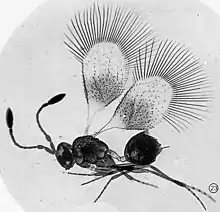Mymarommatidae
The Mymarommatidae, sometimes referred to as False fairy wasps. are a very small family of microscopic hymenopteran insects. Only about half of the known species are living taxa (the others are fossils), but they are known from all parts of the world.[1] Undoubtedly, many more await discovery, as they are easily overlooked and difficult to study due to their extremely small size (most have an overall length of around 0.3 mm).
| Mymarommatidae | |
|---|---|
 | |
| Mymaromella mira holotype | |
| Scientific classification | |
| Kingdom: | Animalia |
| Phylum: | Arthropoda |
| Class: | Insecta |
| Order: | Hymenoptera |
| Superfamily: | Mymarommatoidea |
| Family: | Mymarommatidae Debauche, 1948 |
| Genera | |
|
†Archaeromma Yoshimoto, 1975 | |
Virtually nothing is known about the biology of these insects, but because of their size, and simple ovipositors, entomologists assume they are idiobiont parasitoids on the eggs of various insects. Psocoptera have been suggested as likely hosts based on circumstantial evidence.[2] They were originally treated as an aberrant subfamily of the chalcidoid family Mymaridae but because of morphological differences, are now usually considered in their own superfamily, Mymarommatoidea, and their similarity to Mymaridae is thought to be a result of parallel evolution. Mymarommatids are distinguished by the presence of a pleated (folded) membrane connecting the front and back halves of the head extending from the mandible to the top of the head, which is presumably expanded by muscle or hydrostatic pressure, likely to aid in breaking open the walls of the egg capsule. Specimens are often found in leaf litter and are rare, but occasionally appear in significant numbers.
Classification
As taxonomists have examined this group more closely, they have become less certain about which other group of wasps represents the nearest living relatives of the Mymarommatidae. In recent years, some have claimed the nearest relatives are the extinct family Serphitidae, and therefore claim the Mymarommatidae are essentially "living fossils", the sole surviving lineage of an otherwise extinct superfamily Serphitoidea. It remains to be seen whether this change in classification will be accepted, but it has some significant support.
Palaeomymar is known from a single species (P. succini Meunier) from Eocene aged Baltic amber, while Archaeromma is known from 10 species spread across Laurasia during the Cretaceous dating from the Albian to the Campanian.[3]
Mymaromma has 10 described extant species.[4]
Mymaromella has 6 described extant species.[5] Another species of Mymaromella, M. duerrenfeldi is known from Miocene amber in Sicily.[6]
Zealaromma has two extant species: Z. insulare and Z. valentinei. Both species are known from New Zealand.[1]
References
- Gibson, G.A.P.; Read, J.; Huber, J.T. (2007) Diversity, classification and higher relationships of Mymarommatoidea (Hymenoptera).Journal of Hymenoptera Research 16: 51–146
- Huber, John T.; Gibson, Gary A. P.; Bauer, Leah S.; Liu, Houping; Gates, Michael (2008). "The genus Mymaromella (Hymenoptera: Mymarommatidae) in North America, with a key to described extant species". Journal of Hymenoptera Research. 17 (2): 175–194.
- "Fossilworks: Archaeromma". fossilworks.org. Retrieved 2020-02-17.
- Universal Chalcidoidea Database - Mymaromma - Accessed 27 Jan 2021
- Universal Chalcidoidea Database - Mymaromella - Accessed 27 Jan 2021
- T. Schlüter and R. Kohring. 1990. Die zwergwespengattung Palaeomymar (Hymenoptera: Proctotrupoidea: Serphitidae) aus dem mio/pliozänen Simetit Siziliens. Berliner Geowissenschaftliche Abhandlungen, Reihe A 124:115-121